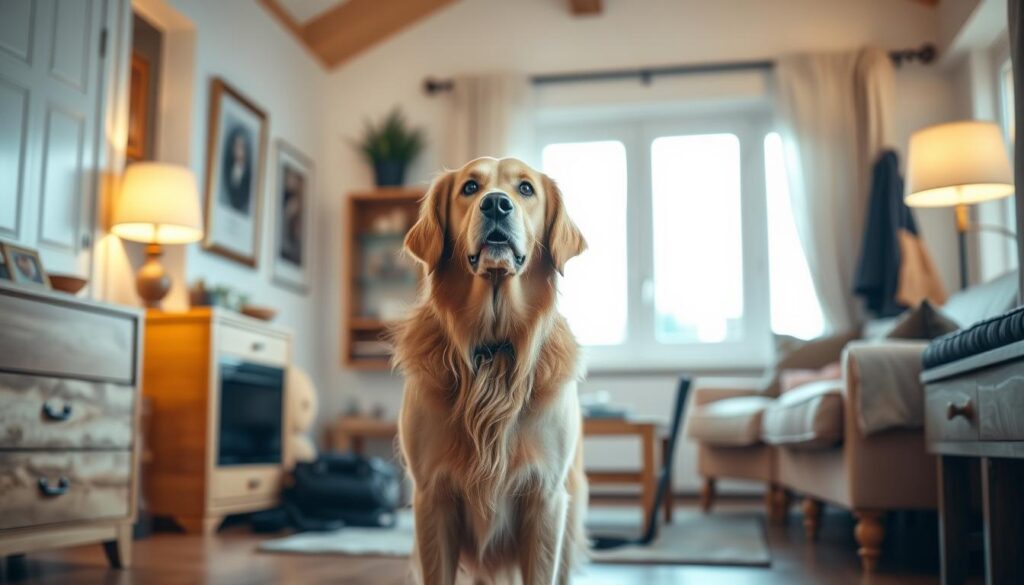Leaving your pet behind can be stressful, and it’s worse if they bark a lot. Mary Burch, Ph.D., says it’s key to know why your dog barks. This helps solve the problem.
To stop the barking, first figure out why it happens. Then, get your pet ready before you leave. Also, tell your dog sitter all they need to know to keep your pet happy and safe.
Good dog barking solutions need preparation and clear talk. With the right dog sitter instructions, you can lessen your pet’s barking. This makes your home and neighborhood quieter and more peaceful.
Key Takeaways
- Understand why your dog barks when left alone
- Prepare your dog before leaving the house
- Provide essential information to your dog sitter
- Reduce barking by creating a comfortable environment
- Improve communication with your dog sitter for better care
Understanding Why Dogs Bark When Left Alone
Dogs may bark when left alone for many reasons. These include anxiety, boredom, or a need to protect their territory. Knowing why they bark is key to solving the problem.
Separation Anxiety vs. Boredom
Dogs bark for two main reasons: separation anxiety or boredom. Both lead to barking, but they have different causes and solutions.
Identifying Anxiety Symptoms
Separation anxiety shows in behaviors like pacing, whining, and drooling. Dogs with this issue get very upset when their owners leave. They show a strong bond with their owners.
Signs of Simple Boredom
Dogs bark due to boredom without showing as much distress. They bark because they’re not getting enough to do. Giving them enough to think and do can stop this barking.
Territorial Barking Triggers
Territorial barking happens when dogs bark at external stimuli like noises or people. They feel the need to guard their territory, leading to constant barking.

Age-Related Barking Issues
A dog’s age affects their barking when left alone. Different ages have unique traits that can lead to barking.
Puppy Barking Behaviors
Puppies bark because they have too much energy or want attention. As they grow, their barking changes, needing new ways to manage it.
Senior Dog Considerations
Senior dogs bark due to age-related problems like cognitive decline or hearing loss. Knowing this helps owners find the right ways to stop their barking.
Preparing Your Dog Before You Leave
To cut down on barking when you’re away, prepare your dog well in advance. Getting your dog ready before you leave can really help. It can lessen barking caused by feeling left out or being bored.
Exercise Requirements Before Departure
Tired dogs are happier and quieter. Make sure your dog gets enough physical and mental play before you go. A tired dog is more likely to sleep quietly than bark a lot. Play a fun, active game or a brain game with your dog before you leave.

Creating a Calm Pre-Departure Routine
A calm routine before you leave can tell your dog it’s time to relax. This can include gentle petting, soothing words, or a calming massage.
Avoiding Emotional Goodbyes
Stay calm when saying goodbye to your dog. Avoid emotional goodbyes, as they can make your dog anxious.
Establishing Departure Cues
Use consistent cues to show your dog it’s okay to leave. A specific cue, like picking up your keys or putting on your coat, can signal your departure.
Gradual Departure Training Techniques
Gradual departure training means starting with small steps away from your dog. This helps your dog get used to being alone, reducing barking.
Essential Information to Provide Your Dog Sitter
When you’re away, your dog sitter takes care of your pet. It’s important to share key details to ensure your dog’s comfort and safety.
Dog’s Daily Schedule and Routines
Telling your dog sitter about your dog’s daily routine is crucial. It helps keep things consistent and reduces your dog’s stress.
Feeding Times and Instructions
Make sure to share your dog’s feeding times and any special diet needs. This includes the type of food, how much, and any allergies.
Bathroom Break Schedule
Give your dog sitter a bathroom break schedule. This ensures your dog gets enough exercise and potty breaks.
Known Barking Triggers
Let your dog sitter know what makes your dog bark. This helps them manage situations that might stress your dog out.
Emergency Contact Information
It’s important to leave emergency contact information. This includes how to reach you and other important contacts.
Veterinarian Details
Give your dog sitter your veterinarian’s details. This way, they can get professional help if needed.
Trusted Neighbor Contacts
Also, list trusted neighbor contacts. They can help in emergencies or if your dog sitter needs extra help.
Dog Sitter Instructions: Preventing Barking When You’re Away
To stop barking when you’re not there, dog sitters need to know what to do. They should follow a plan to keep the dog quiet and happy. This makes sure everyone has a good time.
First Day Approach
The first day is very important. It helps the dog sitter and the dog get along. It sets the mood for the whole stay.
Initial Meeting Strategies
When you first meet, let the dog get used to you. Give it space and let it come to you. For more tips on stopping barking, check out barkingbatty.com.
Setting Boundaries Early
It’s important to set rules early to avoid bad behavior. A routine and being consistent helps the dog know what to do.
Daily Routine Maintenance
Keeping a daily routine helps a lot. It includes regular meals, exercise, and playtime.
Communication Protocols with Owner
Talking well with the owner is key to stopping barking. Keeping them updated and telling them about any problems helps solve issues fast.
Regular Update Schedule
Having a set time to update the owner is good. It keeps them in the loop about the dog’s behavior and any problems.
Problem Reporting Guidelines
Clear rules for reporting problems are important. They help solve barking issues quickly. It’s about knowing how the owner likes to be told and how serious the problem is.
By following these dog sitter instructions and keeping in touch, dog sitters can stop barking. This makes the dog’s stay enjoyable for everyone.
Environmental Modifications to Reduce Barking
Making your dog’s space comfortable and safe is key to less barking when you’re out. A few simple changes can help reduce their stress and anxiety. This makes your home quieter.
Creating a Comfortable Safe Space
A comfy safe space can be made through crate training or a quiet area. It gives your dog a sense of security and comfort.
Crate Training Benefits
Crate training helps with anxiety and stops destructive behavior when you’re away. It offers a cozy, den-like space that dogs find comforting.
Designated Quiet Areas
A quiet area, like a dog bed in a quiet room, is also good. It should be away from windows and outside noise.
Sound Management Techniques
Managing sounds is key to less barking. External noises can make dogs bark. Use white noise machines or soundproofing to block these sounds.
Visual Barrier Considerations
Visual barriers help too. They limit what your dog sees outside, reducing their reaction to outside stimuli.
Window Access Management
Limiting your dog’s window access helps with barking at passersby. Close curtains or use window films to block their view.
Using Curtains and Blinds Effectively
Curtains and blinds control what your dog sees from windows. Closing them reduces barking from outside sights. For more tips on keeping your dog calm when you’re away, see our dog sitting services.
Engaging Activities for Mental Stimulation
Mental stimulation is key for dogs to avoid barking from boredom. Engaging your dog in fun activities keeps them calm when you’re away.
Puzzle Toys and Treat Dispensers
Puzzle toys and treat dispensers are great for mental play. They make your dog work to get a treat, keeping them busy.
Food-Dispensing Toy Options
There are many food-dispensing toys, like Kong toys or Tricky Treat Ball. They make mealtime fun and challenging for your dog.
Difficulty Level Progression
It’s important to make puzzle toys harder as your dog gets better. This keeps them challenged and interested.
Rotating Toy Selection Strategy
Changing your dog’s toys often keeps them exciting. Try new ones or bring back old favorites to keep them engaged.
Scent-Based Activities
Scent-based activities are great for mental play. They use your dog’s natural sense of smell.
Snuffle Mats and Search Games
Snuffle mats and search games are perfect for scent play. Hide treats or toys with a strong scent for your dog to find.
Safe Scent Enrichment Ideas
Make sure scent activities are safe and fun for your dog. Use different scents and hide treats in easy or hard spots.
Physical Exercise Requirements and Techniques
It’s key to give your dog the right exercise for their health and happiness. Regular activity keeps them physically fit and helps reduce barking caused by too much energy or boredom.
Breed-Specific Exercise Needs
Different breeds need different amounts and types of exercise. Knowing these needs helps you provide the best physical activity.
High-Energy Breed Considerations
High-energy breeds like Border Collies and Australian Shepherds need lots of exercise. They benefit from running, agility training, or long play sessions.
Low-Energy Breed Approaches
Low-energy breeds, such as Bulldogs and Pugs, need shorter, gentler exercises. Short walks or light play are best for them.
Indoor Exercise Options
When you can’t go outside, indoor exercises are a good option. Try hide-and-seek, stair climbing, or indoor fetch to keep them active.
Structured Walking Protocols
Having a structured walking routine is important for many dogs. It’s not just about how long you walk, but also the quality of the walk.
Leash Training Reminders
It’s crucial to train your dog to walk well on a leash. Teaching them to walk by your side without pulling makes walks better and more fun.
Mental Stimulation During Walks
Walks can also be mentally stimulating for your dog. Letting them sniff and explore is as good for their mind as physical exercise.
Technology and Tools for Monitoring and Training
There are many tech tools to help manage a dog’s behavior. These tools let owners watch their pets from afar and train them better.
Pet Cameras and Monitoring Systems
Pet cameras are great for keeping an eye on dogs when you’re not home. Some models, like those in recent reviews, have cool features. They offer two-way communication and treat-dispensing capabilities.
Two-Way Communication Features
This lets owners calm their dogs from a distance. It might help reduce barking caused by anxiety.
Treat-Dispensing Cameras
These cameras reward dogs for good behavior. They help reinforce positive actions.
Automatic Feeders and Timers
Automatic feeders keep feeding times regular. This is good for dogs with special diets or routines.
Bark Control Devices
Bark control devices range from ultrasonic to vibration collars. Humane options are out there, but it’s key to know their limitations and downsides.
Humane Options and Limitations
Humane bark control devices aim to stop barking without hurting the dog. But, how well they work depends on the dog and why they bark.
When to Avoid Certain Tools
Some bark control devices aren’t right for all dogs, like those with anxiety. It’s important to pick devices that fit the dog’s needs and personality.
Addressing Different Types of Problem Barking
Dogs bark for many reasons. Understanding why they bark is crucial to solving the problem.
Alert Barking Management
Alert barking happens when dogs hear noises or see strangers. We need to teach them to react less to these things.
Desensitization Techniques
Desensitization techniques are very helpful. They involve slowly getting the dog used to the noise or stranger, then rewarding them for staying calm.
Redirecting Attention
Another way is to redirect the dog’s attention. This means giving them something else to focus on, like a treat or toy.
Attention-Seeking Behavior
Some dogs bark to get attention. To stop this, ignore the barking and reward them when they are calm.
Frustration-Based Barking
Frustration barking happens when dogs can’t get what they want, like a toy or going outside.
Identifying Triggers
The first step is to identify the triggers that cause the frustration.
Calming Techniques
After finding the triggers, use calming techniques. This can be giving them something else to do or using calming aids.
When to Seek Professional Help
If your dog keeps barking, knowing when to get help is key. This article offers tips to help, but some problems need a pro’s touch.
Signs of Severe Anxiety
Dogs with severe anxiety might bark a lot or act out. If their anxiety is really affecting their life or yours, it’s time to get expert advice.
Neighbor Complaint Management
Handling neighbor complaints needs a forward-thinking plan. Proactive communication can stop problems before they start.
Proactive Communication Approaches
Telling your neighbors about your efforts to stop the barking can keep things friendly. Share what you’re doing to fix the issue.
Legal Considerations
Knowing local noise laws is important to avoid legal trouble. Make sure you know the rules in your area to stay on the right side of the law.
Finding a Qualified Behaviorist
When you need help, find a qualified behaviorist who knows dogs. Look for certified experts who deal with dog behavior problems.
By spotting when you need a pro and acting early, you can help your dog be happy and healthy.
Building Long-Term Barking Prevention Strategies
Creating lasting solutions for barking needs patience and consistency. A good plan includes regular training, making changes to the environment, and keeping your dog’s mind and body active. This way, you can greatly lessen your dog’s barking.
Teaching your dog new behaviors is key. Start a routine and stick to it. This helps your dog know what’s expected. Also, making your home a comfortable space and controlling loud noises can help a lot.
It’s also vital to keep your dog’s mind and body busy. Activities like puzzle toys and scent games can distract them from barking. These steps help make your home quieter and strengthen your bond with your dog.
Using these strategies for the long haul can make your home a happier place. It reduces stress and anxiety caused by too much barking.






